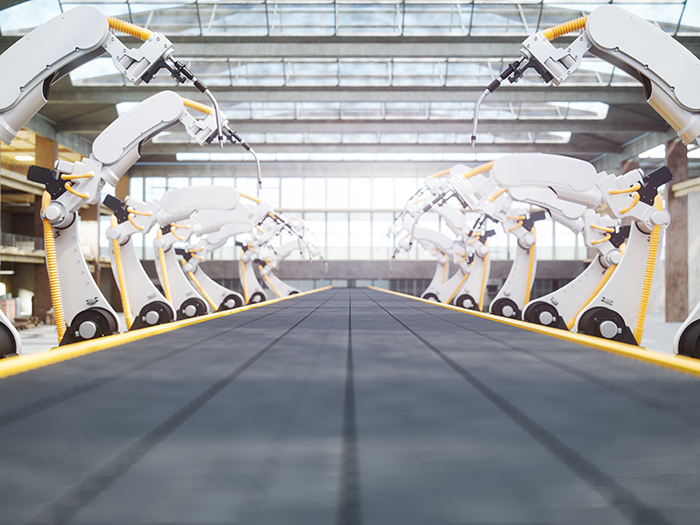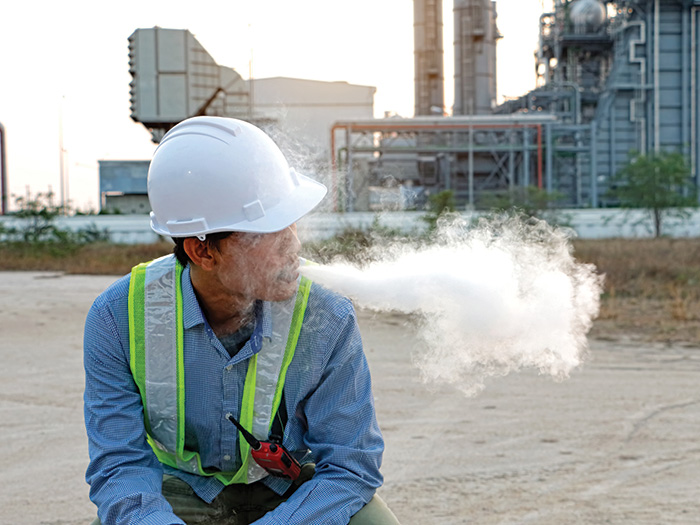Sponsored: Liberty Mutual Insurance
American Manufacturing Is Booming. The Opportunities Are Big, But So Are the Risks

Ask the average citizen what they think about the future of U.S. manufacturing, and you’re likely to hear bleak projections of companies shipping their operations offshore, or robots displacing human workers. Overall, the industry’s public image is fading at the edges — people perceive waning relevance and opportunity.
“But if you ask manufacturers what they think, the response is the exact opposite. U.S. manufacturers are actually quite enthused about the future,” said Seth Hedrington, Senior Vice President and General manager, National Insurance, West Division, Liberty Mutual Insurance. “It’s a very dynamic industry with new opportunities every day.”
Advancements in technology are changing the game in terms of capabilities, efficiency and agility.
“Automation and robotics enable smaller entities to produce at a smaller scale, which puts pressure on every player to become more efficient,” Hedrington said. The benefits of technology, however, are counteracted by rapidly-changing consumer preferences, government regulation, and an ongoing labor shortage. The result is an environment teeming with both opportunity and obstacles.
Here are five ways manufacturers are reacting to a newly competitive environment that may expose them to unforeseen risks:

Seth Hedrington, Senior Vice President and General Manager, National Insurance, West Division, Liberty Mutual Insurance
1. Stretching an existing workforce to combat a shortage of qualified workers.
The inability to attract and retain workers remains a top challenge for manufacturers, in part because the nature of the skill set required is changing rapidly. Because technology plays such a significant role in front-line production processes, manufacturers need people who not only operate the machines, but also understand how they work.
“They need workers who are more adept with technology, and that’s harder to come by,” Hedrington said.
To increase capacity, companies are lengthening or adding shifts for their existing workforce, which increases the likelihood of fatigue and the risk of injury. While co-bots may reduce labor demands and mitigate safety risk over the long term, they too present short-term challenges.
“Introducing new machinery or even new workers creates unfamiliarity, and that initially increases safety risk,” Hedrington said.
These changes also have product liability implications. “When you extend shifts, you’re taxing the equipment as well as your workers,” Hedrington said. “That makes it more difficult to achieve a consistent level of product quality.”
Risk Management Steps:
- Provide ongoing safety training, protective equipment and machine safeguards.
- Get employee buy-in on the adoption of new equipment.
- Give workers advance notice of schedule changes.
2. Adjusting supply chains to address regulatory and trade challenges.
 Thanks to recent tariffs on key imports like aluminum and steel, raw materials are becoming more expensive. “Manufacturers are faced with some of the most extreme fluctuations in the cost of materials that we’ve seen in recent history,” Hedrington said.
Thanks to recent tariffs on key imports like aluminum and steel, raw materials are becoming more expensive. “Manufacturers are faced with some of the most extreme fluctuations in the cost of materials that we’ve seen in recent history,” Hedrington said.
To control costs, some companies are turning to suppliers from regions not impacted by the tariffs. But significant risks always accompany a change in trade relationships. Product defect liability is chief among them, but the risk of supply chain interruption is also an issue.
“If you’re working with alternate suppliers and relationships are not as established, the risk of interruption is greater,” Hedrington said. Failure to deliver products on time ultimately presents a reputational risk and threatens a manufacturer’s ability to keep their contracts.
Risk Management Steps:
- Maintain relationships with previous suppliers.
- Develop contingency plans and a network of backup suppliers.
- Review contract language addressing liability for faulty materials.
3. Diversifying operations to become more nimble and fast-paced.
 Technology makes it easier to stay connected anywhere in the world, and more manufacturers are taking advantage of that to open multiple locations across the U.S. and abroad.
Technology makes it easier to stay connected anywhere in the world, and more manufacturers are taking advantage of that to open multiple locations across the U.S. and abroad.
“As companies start to feel pressured by the competitive environment, they’ll look for opportunities to manufacture in other parts of the world where regulatory hurdles and costs are smaller,” Hedrington said.
That, however, may increase exposure to intellectual property (IP) theft. While cyber breach happens everywhere, an international supply chain typically means a more expansive network, so the potential for infiltration and IP theft is greater. The ability to seek damages for IP theft occurring outside the U.S. can also be more challenging.
“A global network is a lot more difficult to manage—you need to regularly evaluate who has access, what they have access to, and make sure the access is secure,” Hedrington said. Limiting access to confidential information to specific groups or a specific location, like a U.S. headquarters, could help mitigate the exposure.
Risk Management Steps:
- Add language to contracts that protect proprietary and IP rights.
- Limit research and development to company headquarters.
- Review internal IT protections.
4. Making facilities “smarter” to improve production and output.
 More manufacturers are incorporating sensors and internet-enabled technology that allows machines to collect and share data and work together in an automated fashion. This ‘smart’ technology provides valuable insights into the efficiency of production processes.
More manufacturers are incorporating sensors and internet-enabled technology that allows machines to collect and share data and work together in an automated fashion. This ‘smart’ technology provides valuable insights into the efficiency of production processes.
“The risk associated with “smart” machinery is their interconnectivity,” Hedrington said. “Anytime you have that level of connectivity, you have an increased level of risk to cyber breach.” It’s also easier to make unintentional or unauthorized changes to product design and specifications or material thresholds, which could impact product quality and safety.
“Many manufacturers don’t perceive themselves as major targets for cyber-attack, but failing to appreciate and mitigate that exposure can result in significant losses. In addition to reviewing your internal IT safeguards, it’s critical to review your insurance options. If you’re not considering the benefits of insurance, that’s a significant missed opportunity to protect your business,” he said.
Risk Management Steps:
- Update your cyber policy to include both first- and third-party coverage.
- Identify IT vulnerabilities in new technology.
- Strengthen internal security protocols.
5. Selling direct-to-consumer to increase product control and improve profit margins.
 Manufacturers in a variety of consumer product segments, from razors and eyeglasses to mattresses and sneakers, are increasingly exploring direct to consumer models that cut out the middle man. While few manufacturers are abandoning their traditional distribution outlets all together, they are considering e-commerce and even brick-and mortar locations of their own.
Manufacturers in a variety of consumer product segments, from razors and eyeglasses to mattresses and sneakers, are increasingly exploring direct to consumer models that cut out the middle man. While few manufacturers are abandoning their traditional distribution outlets all together, they are considering e-commerce and even brick-and mortar locations of their own.
In addition to increased efficiencies, this format allows manufacturers more control over the customer experience and a bigger share of the profits.
“Going direct-to-consumer is another way to beat out competitors,” Hedrington said. “Technology and the connectivity of everything has helped open up new distribution avenues.”
It also, however, confers liabilities to the manufacturer that the middle-men normally accept, such as product and safety liability for proper packaging and labeling, as well as other operational risks that come with running a storefront, including workers’ compensation, cyber, property and general liability exposures.
Risk Management Steps:
- Don’t completely shut down traditional distribution channels.
- Ensure you have the skills to manage operational risks of direct distribution.
- Build a cross-functional team to build a thorough risk management plan.
Your Insurer’s Experience and Expertise Matter
Manufacturing represents one of the largest business segments that Liberty Mutual serves, and teams across the organization have specialized expertise in the unique challenges facing this evolving sector.
Liberty insures a wide variety of manufacturers, wants to write more, and has the products to address the industry’s specific exposures. The company can offer a holistic solution that includes core property & casualty, as well as cyber, D&O, and environmental lines through Ironshore, a Liberty Mutual company.
“Liberty Mutual is entrenched in the risk management practices of the manufacturing industry. Our risk control professionals participate in many boards and committees that create standards to improve equipment, product, and employee safety. Additionally, our Industry Solutions and Product Management teams have a deep understanding of the manufacturing industry and help customers stay ahead of emerging risks,” Hedrington said.
In addition, Liberty’s claims handlers have the experience, capabilities, and knowledge to deliver quality outcomes so manufacturers can rebound from losses as quickly as possible.
“Our commitment to this space manifests itself in many ways, and that will hold true as U.S. manufacturing continues to evolve,” Hedrington said.
To learn more, visit http://lmi.co/manufacturing.
This article was produced by the R&I Brand Studio, a unit of the advertising department of Risk & Insurance, in collaboration with Liberty Mutual Insurance. The editorial staff of Risk & Insurance had no role in its preparation.











